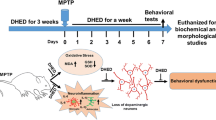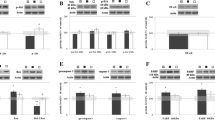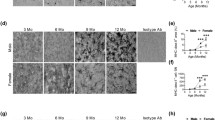Abstract
Studies involving estrogen treatment of ovariectomized rats or mice have attributed to this hormone a neuroprotective effect on the substantia nigra pars compacta (SNpc) neurons. We investigated the effect of estradiol replacement in ovariectomized rats on the survival of dopaminergic mesencephalic cell and the integrity of their projections to the striatum after microinjections of 1 μg of 6-hydroxydopamine (6-OHDA) into the right SNpc or medial forebrain bundle (MFB). Estradiol replacement did not prevent the reduction either in the striatal concentrations of DA and metabolites or in the number of nigrostriatal dopaminergic neurons following lesion with 1 μg of 6-OHDA into the SNpc. Nevertheless, estradiol treatment reduced the decrease in striatal DA following injection of 1 μg of 6-OHDA into the MFB. Results suggest therefore that estrogen protect nigrostriatal dopaminergic neurons against a 6-OHDA injury to the MFB but not the SNpc. This may be due to the distinct degree of lesions promoted in these different rat models of Parkinson’s disease.




Similar content being viewed by others
References
Betarbet R, Sherer TB, Di Monte DA, Greenamyre JT (2002) Mechanistic approaches to Parkinson’s disease pathogenesis. Brain Pathol 12:499–510
Damier P, Hirsch EC, Agid Y, Graybiel AM (1999) The substantia nigra of the human brain II. Nigrosomes and the nigral matrix, a compartimental organization based on calbindin D28k immunohistochemistry. Brain 122:1421–1436
German DC, Manaye K, Smith WK, Woodward DJ, Saper CB (1989) Midbrain dopaminergic cell loss in Parkinson’s disease: computer visualization. Ann Neurol 26:507–514
Halliday GM, McRitchie DA, Cartwright HR, Pamphlett RS, Hely MA, Morris JGL (1996) Midbrain neuropathology in idiopathic Parkinson’s disease and diffuse Lewy body disease. J Clin Neurosci 3:52–60
Hirsch EC, Graybiel AM, Agid Y (1988). Melanized dopaminergic neurons are differentially susceptible to degeneration in Parkinson’s disease. Nature 334:345–348
Fahn S, Przedborski S (2000) Parkinsonism. In: Merritt’s neurology. Lippincott Williams and Wilkins, New York, pp 679–693
Przedborski S (2005) Pathogenesis of nigral cell death in Parkinson’s disease. Parkinsonism Relat Disord 11:S3–S7
Emborg ME (2004) Evaluation of animal models of Parkinson’s disease for neuroprotective strategies. J Neurosci Methods 139:121–143
Cyr M, Calon F, Morissette M, Di Paolo T (2002) Estrogenic modulation of brain activity: implications for schizophrenia and Parkinson’s disease. J Psychiatry Neurosci 27:12–27
Dluzen DE, Disshon KA, McDermott J (1998) Estrogen as a modulator of striatal dopaminergic neurotoxicity. In: Recent advances in neurodegenerative disorders. Prominent Press, Scottsdale, pp 149–192
Dluzen DE, McDermott JL (2000) Gender differences in neurotoxicity of the nigrostriatal dopaminergic system: implications for Parkinson’s disease. J Gend Specif Med 3:36–42
Mayeux R, Denaro J, Hermenegildo N, Marder K, Tang MX, Cote LJ, Stern Y (1992) A population-based investigation of Parkinson’s disease with and without dementia. Relationship to age and gender. Arch Neurol 49:492–497
Amantea D, Russo R, Bagetta G, Corasaniti MT (2005) From clinical evidence to molecular mechanisms underlying neuroprotection afforded by estrogens. Pharmacol Res 52:119–132
Galanopoulou AS, Alm EM, VelíImagek J (2003) Estradiol reduces seizure-induced hippocampal injury in ovariectomized female but not in male rats. Neurosci Lett 342:201–205
Hurn PD, Macrae IM (2000) Estrogen as a neuroprotectant in stroke. J Cereb Blood Flow Metab 20:631–652
Wise PM (2002) Estrogens and neuroprotection. Trends Endocrinol Metab 13:229–230
Berreta N, Freestone PS, Guatteo E, De Castro D, Geracitano R, Bernardi G, Mercuri NB, Lipski J (2005) Acute effects of 6-hydroxydopamine on dopaminergic neurons of the rat substancia nigra pars compacta in vitro. Neurotoxicology 26:869–881
Deumens R, Blokland A, Prickaerts J (2002) Modeling Parkinson’s disease in rats: an evaluating of 6-OHDA lesions of the nigrostriatal pathway. Exp Neurol 175:303–317
Gillies GE, Murray HE, Dexter D, McArthur S (2004) Sex dimorphisms in the neuroprotective effects of estrogen in an animal model of Parkinson’s disease. Pharmacol Biochem Behav 78:513–522
Kirik D, Rosenblad C, Björklund A (1998) Characterization of behavioral and neurodegenerative changes following partial lesions of the nigrostriatal dopamine system induced by intrastriatal 6-hydroxydopamine in the rat. Exp Neurol 152:259–277
Kondoh T, Bannai M, Nishino H, Torii K (2005) 6-Hydroxydopamine-induced lesions in a rat model of hemi-Parkinson’s disease monitored by magnetic resonance imaging. Exp Neurol 192:194–202
Yuan H, Sarre S, Ebinger G, Michotte Y (2005) Histological, behavioural and neurochemical evaluation of medial forebrain bundle and striatal 6-OHDA lesions as rat models of Parkinson’s disease. J Neurosci Methods 144:35–45
Dauer W, Przedborski S (2003) Parkinson’s disease: mechanisms and models. Neuron 39:889–909
Shimohama S, Sawada H, Kitamura Y, Taniguchi T (2003) Disease model: Parkinson’s disease. Trends Mol Med 9:360–365
Moroz IA, Rajabi H, Rodaros D, Stewart J (2003) Effects of sex and hormonal status on astrocytic basic fibroblast growth factor-2 and tyrosine hydroxylase immunoreactivity after medial forebrain bundle 6-hydroxydopamine lesions of the midbrain dopamine neurons. Neuroscience 118:463–476
Murray HE, Pillai AV, McArthur SR, Razvi N, Datla KP, Dexter DT, Gillies GE (2003) Dose- and sex-dependent effects of the neurotoxin 6-hydroxydopamine on the nigrostriatal dopaminergic pathway of adult rats: differential actions of estrogen in males and females. Neuroscience 116:213–222
McArthur S, Murray HE, Dhankot A, Dexter DT, Gillies GE (2007) striatal susceptibility to a dopaminergic neurotoxin is independent of sex hormone effects on cell survival and DAT expression but is exacerbated by central aromatase inhibition. J Neurochem 100:678–692
Dluzen D (1997) Estrogen decreases corpus striatal neurotoxicity in response to 6-hydroxydopamine. Brain Res 767:340–344
Peinado V, González JC, Leret ML (2004) Effect of 17-β-estradiol on dopamine, serotonine and GABA striatal levels in 6-hydroxydopamine-treated rats. Toxicology 204:155–160
Datla KP, Murray HE, Pillai AV, Gillies GE, Dexter DT (2003) Differences in dopaminergic effects ef estrogen during estrous cycle. Neuroreport 20:47–50
Ferraz AC, Xavier LL, Hernandes S, Sulzbach M, Viola GG, Anselmo-Franci JA, Achaval M, Da Cunha C (2003) Failure of estrogen to protect the substancia nigra pars compacta of female rats from lesion induced by 6-hidroxydopamine. Brain Res 986:200–205
Paxinos G, Watson C (1997) The rat brain in stereotaxic coordinates. Academic Press, San Diego
Xavier LL, Viola GG, Ferraz AC, Da Cunha C, Deonizio JMD, Netto CA, Achaval M (2005) A simple and fast densitometric method for the analysis of tyrosine hydroxylase immunoreactivity in the substantia nigra pars compacta and in the ventral tegmental área. Brain Res Protoc 16:58–64
Freeman ME (2006) The neuroendocrine control of the ovarian cycle of the rat. In: Neill JD (ed) Knobil and Neill’s physiology of reproduction. Elsevier, Philadelphia
Di Paolo T, Bedard PJ, Dupont A, Poyet P, Labrie F (1982) Effects of estradiol on intact and denervated striatal dopamine receptors and on dopamine levels: a biochemical and behavior study. Can J Physiol Pharmacol 60:350–357
Calier S, Le Saux M, Lhiaubet AM, Di Paolo T, Rostene W, Pelaprat D (2002) Evaluation of the protective effect of oestradiol against toxicity induced by 6-hydroxydopamine and 1-methyl-4-phenylpyridinium ion (Mpp+) towards dopaminergic mesencephalic neurons in primary culture. J Neurochem 80:307–316
Dluzen DE (2005) Unconventional effects of estrogen uncovered. Trends Pharmacol Sci 26:485–487
Iancu R, Mohapel P, Brundin P, Paul G (2005) Behavioral characterization of a unilateral 6-OHDA-lesion model of Parkinson’s disease in mice. Behav Brain Res 162:1–10
Jeon BS, Jackson-Lewis V, Burke RE (1995) 6-hydroxydopamine lesion of the rat substantia nigra: Time course and morphology of cell death. Neurodegeneration 4:131–137
Truong L, Albutt H, Kassiou M, Henderson JM (2006) Developing a preclinical model of Parkinson’s disease: A study of behavior in rats with graded 6-OHDA lesions. Behav Brain Res 169:1–9
Tamás A, Lubics A, Szalontay L, Lengvári I, Reglödi D (2005) Age and gender differences in behavioral and morphological outcome after 6-hydroxydopamine-induced lesion of the substancia nigra in rats. Behav Brain Res 158:221–229
Sullivan RM, Szechtman H (1994) Left/right nigrostriatal asymmetry in susceptibility to neurotoxic dopamine depletion with 6-hydroxydopamine in rats. Neurosci Lett 170:83–86
Dauer W, Przedborski S (2003) Parkinson’s disease: mechanisms and models. Neuron 39:889–909
Ekue A, Boulanger JF, Morissette M, Di Paolo T (2002) Lack of effect of testosterone and dihydrotestosterone compared to 17beta-oestradiol in 1-methyl-4-phenyl-1,2,3,6, tetrahydropyridine-mice. Neuroendocrinology 14:731–736
Behrouz B, Drolet RE, Sayed ZA, Lookingland KJ, Goudreau JL (2007) Unique responses to mitochondrial complex I inhibition in tuberoinfundibular dopamine neurons may impart resistance to toxic insult. Neuroscience 147:592–598
Acknowledgements
The authors are indebted to Tatiana Nemoto Piccoli Moraes, Renata Lins Fuentes Araújo, Janyana Marcela Doro Deonízio and Renata Vaguetti for their participation in some experiments and to Ruither Oliveira Carolino for technical support. The financial support of CNPq, CAPES and FAPESP is also acknowledged.
Author information
Authors and Affiliations
Corresponding author
Rights and permissions
About this article
Cite this article
Ferraz, A.C., Matheussi, F., Szawka, R.E. et al. Evaluation of Estrogen Neuroprotective Effect on Nigrostriatal Dopaminergic Neurons Following 6-Hydroxydopamine Injection into the Substantia Nigra Pars Compacta or the Medial Forebrain Bundle. Neurochem Res 33, 1238–1246 (2008). https://doi.org/10.1007/s11064-007-9575-7
Received:
Accepted:
Published:
Issue Date:
DOI: https://doi.org/10.1007/s11064-007-9575-7




